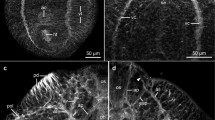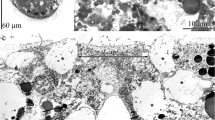Abstract
Two types of frontal glands were detected in plerocercoids ofDiphyllobothrium dendriticum and their fates during the development from plerocercoid to adult worm were followed. Type I—the green glands—dominate the scolex of the larvae. They are located posteriorly and peripherally in the scolex and in the cortical and medullary parenchyma of the neck. The glands empty into the frontal pit. Type II—the golden glands—have earlier eluded observation or been mingled with the green glands. The golden glands are confined to the scolex and are closely associated with the nervous system. The green glands are activated during the first day of cultivation in vitro and in vivo. Already after 12 h of cultivation most of the green gland material has been secreted. The process continues, rapidly emptying ducts and cells. The green glands disappear completely within three days. The golden glands remain, on the whole, unaltered throughout the maturation of the worm and still occur in the adult worm. The roles of the two glands are discussed.
Similar content being viewed by others
References
Andersen K (1975) The functional morphology of the scolex ofDiphyllobothrium Cobbold (Cestoda, Pseudophyllidea). A scanning electron and light microscopical study on scoleces of adultD. dendriticum (Nitzsch),D. latum (L.) andD. ditremum (Creplin). Int J Parasitol 5:487–493
Bylund G (1969) Experimentell undersökning avDiphyllobothrium dendriticum (=D. norvegicum) från norra Finland. Tiedoksianto-Information Parasitol Inst Soc Scient Fennica 10:3–17
Gustafsson MKS, Wikgren MC (1981) Peptidergic and aminergic neurons in adultDiphyllobothrium dendriticum Nitzsch, 1824 (Cestoda, Pseudophyllidea). Z Parasitenkd 64:121–134
Gustafsson MKS, Wikgren MC (1981) Activation of the neurosecretory system inDiphyllobothrium dendriticum (Cestoda, Pseudophyllidea) Parasitology 83:243–247
Halvorsen O (1970) Studies of the helminth fauna of Norway XV: On the taxonomy and biology of plerocercoids ofDiphyllobothrium Cobbold, 1858 (Cestoda, Pseudophyllidea) from North-western Europe. Nytt Mag Zool 18:113–174
Halvorsen O, Andersen K (1974) Some effects of population density in infections ofDiphyllobothrium dendriticum (Nitzsch) in golden hamster (Mesocricetus auratus Waterhouse) and common gull (Larus canus L.). Parasitology 69:149–160
Hayunga EG (1979) The structure and function of the scolex glands of three caryophyllid tapeworms. Proc Helminthol Soc Wash 46:171–179
Krause E (1960) Untersuchungen über die Neurosekretion im Schlundring vonHelix pomatia. Z Zellforsch 51:748–776
Kuhlow F (1953) Bau und Differentialdiagnose heimischerDiphyllobothrium-Plerocercoide. Tropenmed Parasitol 4:186–202
Öhman-James C (1973) Cytology and cytochemistry of the scolex gland cells inDiphyllobothrium ditremum (Creplin, 1825). Z Parasitenkd 42:77–86
Wendelaar Bonga SE (1970) Ultrastructure and histochemistry of neurosecretory cells and neurohaemal areas in the pond snailLymnaea stagnalis (L.). Z Zellforsch 108:190–224
Author information
Authors and Affiliations
Rights and permissions
About this article
Cite this article
Gustafsson, M.K.S., Vaihela, B. Two types of frontal glands inDiphyllobothrium dendriticum (Cestoda, Pseudophyllidea) and their fate during the maturation of the worm. Z. Parasitenkd. 66, 145–154 (1981). https://doi.org/10.1007/BF00925721
Received:
Issue Date:
DOI: https://doi.org/10.1007/BF00925721




